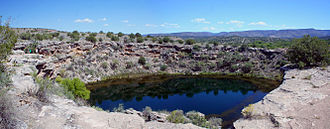- Motobdella montezuma
-
Motobdella montezuma Scientific classification Kingdom: Animalia Phylum: Annelida Class: Clitellata Subclass: Hirudinea Family: Erpobdellidae Genus: Motobdella Species: M. montezuma Binomial name Motobdella montezuma
(Davies, Singhal & Blinn, 1985) [1]Synonyms [2] Erpobdella montezuma Davies, Singhal & Blinn, 1985
Motobdella montezuma is a species of leech which is only found in Montezuma Well, central Arizona, United States. It is a nocturnal pelagic predator that feeds almost exclusively on the endemic amphipod Hyalella montezuma, which it detects using passive sonar and swallows whole.
Contents
Description
Adults of M. montezuma may reach a length of 71 mm (2.8 in) including the suckers at the front and rear.[3]
Distribution
M. montezuma is closely related to the genus Erpobdella,[4] which includes species that are widespread across North America from Alaska to Mexico.[5] However, M. montezuma is only known to occur in a single pool, Montezuma Well, in the Montezuma Castle National Monument in Yavapai County, Arizona.[6]
Ecology
Montezuma Well is too small to support a healthy population of fish, leaving an ecological niche of open-water predator free. Although there are a number of species of invertebrates living in the well, the diet of M. montezuma consists almost entirely of the endemic amphipod Hyalella montezuma.[6]
Behavior
M. montezuma is nocturnal, resting at the bottom of the well during the day, when predatory waterfowl are present.[7] As night falls, the leeches swim towards the surface and hunt amphipods near the surface; this is the only instance of a leech hunting in open water.[7] Prey are detected by passive sonar, and swallowed whole. This pattern of diel vertical migration by a leech is only known to occur in Montezuma Well.[7]
Life cycle
Like many other leeches, M. montezuma is hermaphroditic. Sexual reproduction results in two individuals fertilizing each other, and the resulting eggs are placed in a nutrient-filled cocoon. The cocoon is placed deep enough to avoid the attention of ducks and other predators, and the eggs hatch into self-sufficient juveniles.[7]
References
- ^ "Motobdella montezuma". Integrated Taxonomic Information System. http://www.itis.gov/servlet/SingleRpt/SingleRpt?search_topic=TSN&search_value=568959.
- ^ "Erpobdellidae". Texas A&M University. http://insects.tamu.edu/research/collection/hallan/test/Annelida/Family/Erpobdellidae.txt. Retrieved April 19, 2010.
- ^ Fredric R. Govedich, Dean W. Blinn, Paul Keim & Ronald W. Davies (1998). "Phylogenetic relationships of three genera of Erpobdellidae (Hirudinoidea), with a description of a new genus, Motobdella, and species, Motobdella sedonensis". Canadian Journal of Zoology 76 (12): 2164–2171. doi:10.1139/cjz-76-12-2164.
- ^ James H. Thorp & Alan P. Covich (2001). Ecology and classification of North American freshwater invertebrates (2nd ed.). Academic Press. ISBN 9780126906479.
- ^ Roy T. Sawyer (1970). "Observations on the natural history and behavior of Erpobdella punctata (Leidy) (Annelida: Hirudinea)". American Midland Naturalist 83 (1): 65–80. http://www.jstor.org/stable/2424006.
- ^ a b Dean W. Blinn, Ronald W. Davis & Behrooz Dehdashti. "Specialized open water feeding by the leech, Erpodbella montezuma (Hirudinea)". Northern Arizona University. http://dana.ucc.nau.edu/~are-p/research/researchers/blinn.html. Retrieved April 19, 2010.
- ^ a b c d Fredric R. Govedich & Bonnie A. Bain (2005). "All about the leeches of Montezuma Well". National Park Service. http://www.nps.gov/moca/naturescience/upload/Montezuma_Well_Leeches.pdf. Retrieved April 19, 2010.
Categories:- Leeches
- Endemic fauna of the United States
- Fauna of the Southwestern United States
- Natural history of Arizona
- Animals described in 1985
Wikimedia Foundation. 2010.

